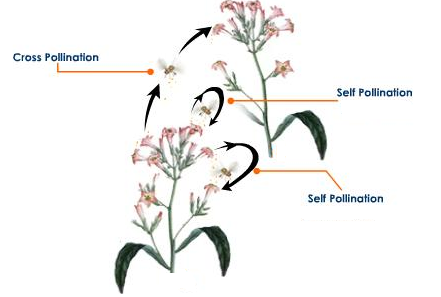7th Grade > Biology
REPRODUCTION IN ORGANISMS MCQs
:
Definition: 1 Mark
Example: 1 Mark
The flowers which contain both male reproductive part (stamen) and female reproductive part (pistil) are called bisexual flowers.
Example: Hibiscus.
:
Each point: 1 Mark
The advantages of vegetative propagation are
1. It is a cheaper, easier and more rapid method of propagation in plants than growing plants from their seeds.
2. Plants which do not produce seeds can be propagated by this method.
3. The new plants are exact copies of the parent plant.
:
Each point: 1 Mark
1. Vegetative parts- Parts of a plant which do not participate in sexual reproduction process are called vegetative parts. Roots, stems and leaves are the vegetative parts of a plant.
2. Reproductive parts- Parts of a plant which participate in the sexual reproduction process are called reproductive parts. Flowers, fruits, and seeds are called the reproductive parts of a plant.
:
Each point: 1 Mark
1. The process by which an organism gives birth to young ones of its own kind is called reproduction.
2. Reproduction is essential for continuity of species.
:
Each point: 1 Mark
1. The transfer of pollen from the anther to the stigma of a flower is called pollination.
2. The two types of pollination are self-pollination and cross-pollination.
3. If the pollen lands on the stigma of the same flower or when the pollen of a flower lands on the stigma of another flower of the same plant it is called self-pollination. When pollen lands on the stigma of a different flower on another plant but of the same species, it is called cross-pollination. 
:
Each reason: 1 Mark
Seed dispersal helps the plant
1. To prevent overcrowding.
2. To avoid competition for sunlight, water, and minerals.
3. To invade new habitats.
:
Explanation: 2 Marks
Examples: 1 Mark
Cutting method is a technique of vegetative reproduction in plants. In this method, a branch of the stem is cut out from the plant and buried in the soil. New leaves arise from the nodes in the stem and the new roots also develop giving rise to a whole new plant.
Example- rose, sugarcane
:
Each point: 1 Mark
1. After fertilization, the ovary grows into a fruit.
2. The seeds develop from the ovules.
3. The other parts of the flower fall off.
:
Explanation: 1 Mark
Examples: 2 Marks
Bulbs are stems which are very small and disc-like and function as food storage organs during dormancy. From the stem arise scaly and fleshy leaves which bear buds in their axils. Examples- onions and garlic.
:
Naming all parts: 1 Mark
Explanation: 1 Mark each
Following are the different parts of a flower:
a)Sepal- The green leafy part of a flower that protects the flower during the bud stage.
b)Petal- The bright, colourful part of a flower that attract insects for pollination.
c)Stamen- The male reproductive part of a flower. Stamen has two parts - anther and filament. Anther produces the pollen grains.
d)Pistil- The female reproductive part of a flower. It has three parts - stigma, style and ovary. Ovary contains the ovule which produces the egg cells.
















